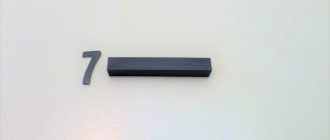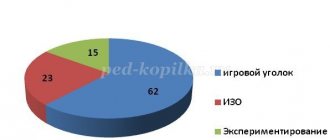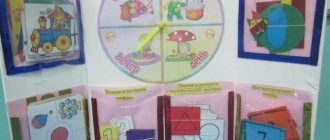Mathematics for preschoolers on Cuisenaire sticks. Where to start getting acquainted with chopsticks?
We offer you an overview of the exercises recorded at the webinar by the author of educational games, Bella Borisovna Finkelshtein.
Believe it or not, all the math concepts a child learns from 2nd through Pre-K can be illustrated using colored counting sticks.
Let's show this in basic game exercises.
Simple math concepts:
One and many. Many and one.
Where is one? Where is there a lot?
Comparison of sets. More less; longer is shorter.
We show the concept of equality on sticks.
Concept of numbers.
Each stick has a name, it is written
is expressed in numbers. (Cardboard numbers and signs are included with the game.)
Let's sign the blue stick, and the pink one... What's the name of the red stick, let's find a number for it!
Composition of numbers from units. How many units are in a number, so is the number.
Children's research activity: determine how many units are in a pink stick, in a black stick. The length of each stick can be indicated by a number, and when comparing, use the signs ><=
We form the idea of more, less. How much more (less). Equalization.
| 3 is more than 2 by 1 | 6 is less than 7 by 1 |
Natural series. Construction of natural series.
First stage: we build a row up to 5, the second stage - from 5 to 10. We build rows in two planes - vertical and horizontal.
Let's build a ladder! (What's the next step? Let's count! (one, two, three....)
Another research work is to prove that each subsequent number is 1 more or 1 less than the previous one.
Sticks can be combined into families:
| White family: | Black family: |
| Red family: | Blue family: |
| Yellow family: | |
| It may be noted that some numbers are included in several families. As you guessed, families combine numbers that are multiples of 2,3,5 and prime numbers. One and seven - families - singles. |
7. Composition of a number from two smaller ones.
A very effective exercise for consolidating the composition of a number from two smaller ones.
Children will not only remember the composition, but also choose the number themselves and feel the composition tactilely.
Example exercises:
We will weave rugs.
Let's weave a carpet. Let's fold the number 7 carpet:
Or we'll assemble a runway for an airplane...
It is useful to write down (code) your rug using numbers. Decoding is also interesting.
Solution of examples:
We supplement the solution of the examples with numbers and signs.
| Addition. | Subtraction: |
Drawing up problems based on models.
Children are happy to come up with problems using the proposed models for addition and subtraction.
7 sparrows were sitting on a branch, 2 more sparrows flew in, how many sparrows are sitting on the branch? There were 7 cars in the parking lot, 2 more parked.... etc. Children's imagination is limitless. What will your task be about?
Prepare to understand the operations of multiplication and division.
| Multiplication: How many rows? How many in one row? How much in total? | Division: Two is the measure of an object. |
11. Going through ten.
In many languages, the numbers of the second ten sound the same: five times ten. We take Ten (twenty) and put five on it. That makes fifteen.
Let's make thirteen, seventeen from sticks!
Names of numbers that are multiples of ten. Fifty - five tens.
What does thirty look like? or eighty?
We saw the possibilities of using sticks to solve arithmetic problems.
Consider the use of sticks in geometry.
Square.
Research work: prove that all sides of a square are equal. (Take a measurement and apply it to each side).
Rectangle. We prove the equality of opposite sides.
Triangle. We count the number of angles and sides.
Polygons, angles: right, acute, obtuse.
All of these exercises can be gradually introduced as part of a lesson (GCD).
For use in classes, you will need one box of colored Cuisenaire counting sticks for 2-3 people.
And, of course, in the educational process we use games and manuals that allow you to systematically work with colored Cuisenaire counting sticks.
| Younger age | Average age | Older age |
Similarities with Dienesh's technique
In the 60s of the last century, a similar technique was created by the Hungarian theoretician Zoltan Dienes. But benefits have several differences. There are a total of 48 blocks in the box , each with four different parameters:
- shape - triangles, squares, rectangles and circles;
- colors - blue, yellow and red;
- thickness - narrow and wide;
- size - small and large.
This diversity makes it possible to more broadly classify objects according to characteristics, using them to solve mathematical and logical tasks. The child learns to generalize and compare concepts. Cuisenaire's sticks are aimed specifically at working with numbers and mathematical operations, and Dienesh's blocks increase the child's intellectual level in all areas.
First stage exercises
Lessons with Cuisenaire cubes take place in two stages: familiarization with the material and formation of the concept of numbers.
First you need to develop visual memory and fine motor skills. Children are asked to distribute all the sticks into groups by color, fold them into a ladder or other shapes. Then the blocks are classified according to other characteristics - length, class of numbers, and simple arithmetic operations are performed. Game lessons begin at one year of age. At this age, children perform familiarization tasks:
- just look at the blocks;
- say the colors of the sticks out loud;
- name other characteristics - length, number value;
- They are trying to build certain shapes from blocks, which their parents will name.
It is better to put such activities in the form of a fairy tale. For example, about a sweet tooth who cannot choose a candy. Whether it is worth eating one red one or several white ones will be determined by the child himself. This way he will learn to add and subtract. You can ask your child to build fences for the little piglets - tall blue for one, medium-sized orange sticks for the second and low white for the third. This will help you learn to compare different quantities.
By the age of three, the list of tasks increases:
- you need to arrange the blocks according to length and shade;
- repeat all the actions of an adult - lay out a figure or line up sticks the way dad or mom did;
- memorization tasks - you need to place blocks in front of the child in a certain order, then remove one of them and ask the child to restore the row;
- measuring the length of surrounding objects using one stick;
- Compare the sizes of different products by touch with your eyes closed.
>
Making your own counting sticks
The set contains parallelepipeds ranging in size from 10 to 1 cm; they differ in color and material from which they are made. There are also instructions for colored Cuisenaire counting sticks, templates for different numbers and a manual with recommendations and a list of steps, tasks and examples. The lengths of the bars indicate numbers, and the colors indicate their classes.
The longer the stick, the larger the number; each centimeter adds one. Groups and classes are divided by shade: red - numbers that are multiples of two, green and blue are divided by three, units are indicated by white, and divisible by 5 and 10 - orange and yellow. The classic collection contains 241 sticks, but for preschoolers they produce simplified sets of 119 or 144 blocks. In some models, green is replaced by blue or purple, and red by pink.
Parents do not have to purchase a ready-made set; they can make it themselves. Sticks are made from wooden blocks or colored cardboard. The first option will allow the child to navigate not only by the shades and length of the product, but also by its volume. On the Internet you can find a table of the sizes of each block, as well as stencils and templates. They are printed and used to cut out sticks from the selected material. Wooden sticks are coated with a layer of acrylic paint in a tone corresponding to the class of numbers.
It is advisable to write numbers on cardboard products, so children will remember them faster. If classes are conducted using a magnetic board, then small magnets are also attached to the back of the blocks. Pre-prepare a box for storage. It should have different sections for each color of stick. After lessons, the child will independently arrange the blocks into the appropriate cells. This will help develop self-discipline and teach your child order.






